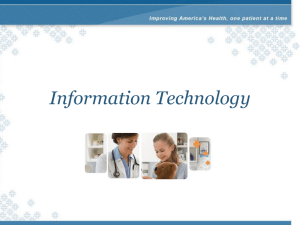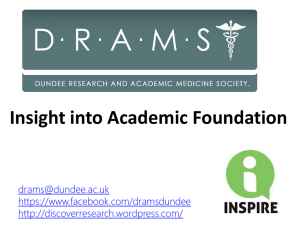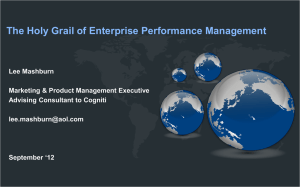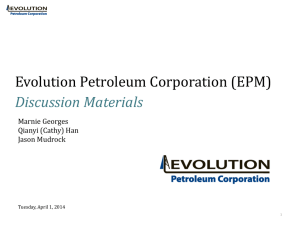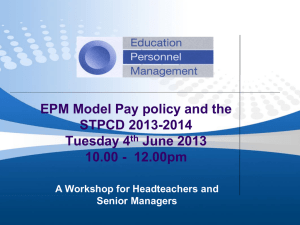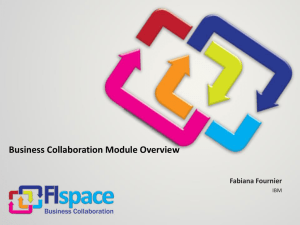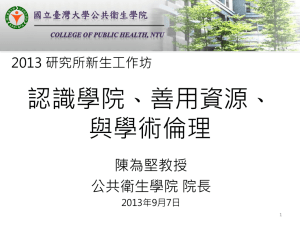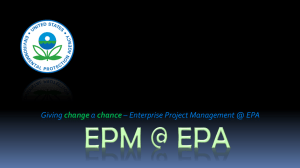Roberto Escarré - Universidad de Alicante
advertisement
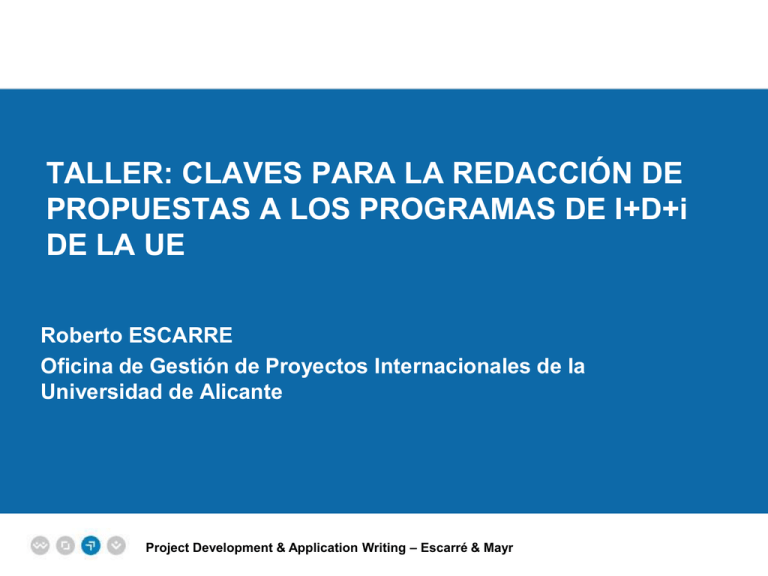
EPM EUROPEAN PROJECT MANAGEMENT TRAINING TALLER: CLAVES PARA LA REDACCIÓN DE PROPUESTAS A LOS PROGRAMAS DE I+D+i DE LA UE Roberto ESCARRE Oficina de Gestión de Proyectos Internacionales de la Universidad de Alicante Project Development & Application Writing – Escarré & Mayr EPM EUROPEAN PROJECT THEMATIC INDEX MANAGEMENT TRAINING I. INTRODUCTION TO PROJECT FINANCING INTRO FUNDRAISING: EC BASIC VOCABULARY THE EC PROJECT LIFE CYCLE TRANSNATIONAL COOPERATION & ADVANTAGES II. PROJECT DEVELOPMENT AND APPLICATION WRITING ANALYSING CALL DOCUMENTATION PARTNERS SEARCH & CONSORTIUM BUILDING STRATEGIES FOR SUCCESSFUL PARTICIPATION APPLICATION PROCESS & DRAFTING III. QUESTIONS Project Development & Application Writing – Escarré & Mayr EPM EUROPEAN PROJECT MANAGEMENT TRAINING EU PROJECTS - BASIC VOCABULARY: Deliverables / outputs / outcomes / expected results / impact Sustainability: financial, political, institutional Dissemination for sustainability Budget: person months, per diems, mobilities, eligible costs, ineligible costs, audit costs, overheads, subcontracting Target groups (direct / indirect), final beneficiaries Consortium: coordinator, grant holder, beneficiary, co-beneficiaries, subcontractors, external experts Risks, assumptions, contingency plan/measures, Capacity building, training for trainers, multiplier effects, … …........ Project Development & Application Writing – Escarré & Mayr EPM EUROPEAN PROJECT MANAGEMENT TRAINING THE EC PROJECT LIFE CYCLE PM Priorities Call for Proposal Areas Instruments Work Programme Idea Guide for Proposers Consortium Project Development & Application Writing – Escarré & Mayr Check - Preins Proposal EPM EUROPEAN PROJECT MANAGEMENT TRAINING THE EC PROJECT LIFE CYCLE Proposal Eligibility Check Expert´s assessment Assessment criteria Selection Hearing Consortium Ethical Checking Final List Formal Communication Negotiation invitation/ Rejection / Reserve List Project Development & Application Writing – Escarré & Mayr EPM EUROPEAN PROJECT THE EC PROJECT LIFE CYCLE MANAGEMENT TRAINING Proposal modulation Negotiation invitation Draft agreement Technical content Agreement Annex I Budget Others Check Negotiation Commission's signature Annex II Annex III Fail = Rejection Consortium Consortium agreement Project Development & Application Writing – Escarré & Mayr Signature Start up EPM EUROPEAN PROJECT MANAGEMENT TRAINING ADVANTAGES WHEN PARTICIPATING IN PROJECTS R&D + INNOVATION R & D + Innovation: Study of the state of the art Existence of technological risk Benefit or Loss Source Contribution to competitiveness = TECHNOLOGICAL AND ENTERPRISE SCIENTIFIC CHALLENGE Project Development & Application Writing – Escarré & Mayr EPM EUROPEAN PROJECT MANAGEMENT TRAINING TECHNOLOGICAL AND ECONOMIC IMPACT Technological and Economic Impact Technological Renovation. Acquisition of new knowledge Access to technological information of strategic nature when collaborating in international consortiums ( Privileged Contacts) To share risks of R & D with other entities. Financial aid and returns that allows to aim more ambitious technological objectives. Project Development & Application Writing – Escarré & Mayr EPM EUROPEAN PROJECT MANAGEMENT TRAINING MARKET IMPACT Access to new potential markets, for its individual development or in cooperation with international partners. Corporative image and credibility before clients and partners. Increase of the visibility and of the enterprise or institutional prestige. Competitive advantage as a result of being at top level in innovating subjects. Project Development & Application Writing – Escarré & Mayr EPM EUROPEAN PROJECT MANAGEMENT TRAINING STRATEGIC ASPECTS TO BE CONSIDERED Reasons to undertake a project Advantages that can be obtained Rights (preliminary and as a result of the project) Obligations Assumable effort by the organization (human and material resources) Project Development & Application Writing – Escarré & Mayr EPM EUROPEAN PROJECT MANAGEMENT TRAINING Strategic aspects to be considered It is advisable to bear in mind that a European project is very profitable and attractive if it is framed in the habitual activities of the organization, if it is in line with its capacities and if it responds to its needs. Project Development & Application Writing – Escarré & Mayr EPM EUROPEAN PROJECT MANAGEMENT TRAINING SUMMARY…. Strategic aspects to be considered Reasons to undertake the project Reduction of the risk associated to the innovation Privileged contacts with Pan-European partners Increase of the visibility and enterprise prestige Advantages Non-refundable subsidy of, at least, 50%. Access to excellent technological information (competitive advantage). Project Development & Application Writing – Escarré & Mayr EPM EUROPEAN PROJECT MANAGEMENT TRAINING THEMATIC INDEX I. INTRODUCTION TO PROJECT FINANCING INTRO FUNDRAISING: EC BASIC VOCABULARY INTRO FUNDRAISING FOR SMEs TRANSNATIONAL COOPERATION & ADVANTAGES II. PROJECT DEVELOPMENT AND APPLICATION WRITING ANALYSING CALL DOCUMENTATION PARTNERS SEARCH & CONSORTIUM BUILDING STRATEGIES FOR SUCCESSFUL PARTICIPATION APPLICATION PROCESS & DRAFTING III. QUESTIONS Project Development & Application Writing – Escarré & Mayr EPM EUROPEAN PROJECT MANAGEMENT TRAINING Step 1. Identify relevant calls for proposals –identify a call that is relevant to your organisation or to an idea you may have for a research project Step 2. Obtain call-specific documentation and forms – The Commission publishes a separate information package which includes a comprehensive Guide for Proposers that offers practical advice for preparing and submitting proposals under each call. Step 3. Establish consortium of researchers, developers and end-users – The proposer must recruit partners to form a consortium capable of undertaking all aspects of the intended project Step 4. Prepare research proposal Step 5. Submit proposal to Commission by call deadline Project Development & Application Writing – Escarré & Mayr EPM EUROPEAN PROJECT MANAGEMENT TRAINING Step 1. Identify relevant calls for proposals –identify a call that is relevant to your SME or to an idea you may have for a research project Step 2. Obtain call-specific documentation and forms – The Commission publishes a separate information package which includes a comprehensive Guide for Proposers that offers practical advice for preparing and submitting proposals under each call. Step 3. Establish consortium of researchers, developers and end-users – The proposer must recruit partners to form a consortium capable of undertaking all aspects of the intended project Step 4. Prepare research proposal Step 5. Submit proposal to Commission by call deadline Project Development & Application Writing – Escarré & Mayr EPM EUROPEAN PROJECT MANAGEMENT TRAINING FUNDING PROGRAMMES Is my type of research, innovation or enterprise development activity eligible? FP7 – Horizon 2020 Competitiveness and Innovation Framework Programme (CIP) European Agricultural Fund for Rural Development (EAFRD) Structural Funds (SF) …. SEE http://cordis.europa.eu/eu-fundingguide/checklist02_en.html#checklist Project Development & Application Writing – Escarré & Mayr EPM EUROPEAN PROJECT WHERE TO FIND RELEVANT INFORMATION MANAGEMENT TRAINING Programme websites, such as CORDIS for FP7: http://cordis.europa.eu Participants Portal: http://ec.europa.eu/research/participants/portal/page/fp7_calls Subscribe to Newsletters / News / E-mail notification services National Contact Points: FP7: http://cordis.europa.eu/fp7/get-support_en.html CIP - IEE: http://ec.europa.eu/energy/intelligent/contact/national_en.htm Horizon 2020: http://ec.europa.eu/research/horizon2020/index_en.cfm Project Development & Application Writing – Escarré & Mayr EPM EUROPEAN PROJECT MANAGEMENT TRAINING HOW TO FIND A CALL ? Get acquainted with the existing programmes in your area Make a list of the most interesting websites for you (favorites) Subscribe to newsletters and services Dedicate some time each week to MONITOR what is going on (i.e. 30 min each week may be enough) Attend events organised in your country to learn about new programmes and projects ….. Project Development & Application Writing – Escarré & Mayr EPM EUROPEAN PROJECT MANAGEMENT TRAINING Step 1. Identify relevant calls for proposals –identify a call that is relevant to your SME or to an idea you may have for a research project Step 2. Obtain call-specific documentation and forms – The Commission publishes a separate information package which includes a comprehensive Guide for Proposers that offers practical advice for preparing and submitting proposals under each call. Step 3. Establish consortium of researchers, developers and end-users – The proposer must recruit partners to form a consortium capable of undertaking all aspects of the intended project Step 4. Prepare research proposal Step 5. Submit proposal to Commission by call deadline Project Development & Application Writing – Escarré & Mayr EPM EUROPEAN PROJECT MANAGEMENT TRAINING STUDY THE DOCUMENTS RELATED TO THE CALL TO FIND THE ANSWER TO THE FOLLOWING QUESTIONS… Am I eligible for a given programme or funding source? Is my type of research, innovation or enterprise development activity eligible? What type of financial support can I obtain? Who else should be involved in the project? What about my timeframe? How is the application process? Project Development & Application Writing – Escarré & Mayr EPM EUROPEAN PROJECT MANAGEMENT TRAINING TYPICAL PROPOSAL DOCUMENTS For each Call you will find an “information package“ which contains all relevant documents: Documents use Call Fiche Deadlines, Topics and Themes *eligibility of your idea Work Programme(s)** Guide for Applicants / for proposers** EPSS Guide / eForm userguide Application form Preparation and Submission * Rules for participation, funding Model Grant Agreement (Contract) Rules for evaluation of proposals Guidelines for financial and administrative issues, reporting guidelines, negotiation Background (for preparation) Further background papers (white / green papers, EU regulations…) Project Development & Application Writing – Escarré & Mayr EPM EUROPEAN PROJECT MANAGEMENT TRAINING CALL INFORMATION– EXAMPLE FP7 General information about the Framework Programme and its content: CORDIS FP7 website http://cordis.europa.eu/fp7/home_en.html Current work programmes for each field: http://cordis.europa.eu/fp7/wp_en.html#cooperation All Open Calls arranged by specific programme can be found at: http://cordis.europa.eu/fp7/dc/index.cfm Project Development & Application Writing – Escarré & Mayr EPM http://ec.europa.eu/research/participants/portal/page/call_FP7#wlp_call_FP7 EUROPEAN PROJECT MANAGEMENT TRAINING Project Development & Application Writing – Escarré & Mayr EPM EUROPEAN PROJECT MANAGEMENT TRAINING Information Package FP 7 Project Development & Application Writing – Escarré & Mayr EPM EUROPEAN PROJECT MANAGEMENT TRAINING CALL DOCUMENTATION: Example CIP-ECO Innovation http://ec.europa.eu/environment/eco-innovation/apply-funds/callproposal/ Possible exercise: Find funded project in past calls…. Project Development & Application Writing – Escarré & Mayr EPM EUROPEAN PROJECT MANAGEMENT TRAINING Step 1. Identify relevant calls for proposals –identify a call that is relevant to your SME or to an idea you may have for a research project Step 2. Obtain call-specific documentation and forms – The Commission publishes a separate information package which includes a comprehensive Guide for Proposers that offers practical advice for preparing and submitting proposals under each call. Step 3. Establish consortium of researchers, developers and end-users – The proposer must recruit partners to form a consortium capable of undertaking all aspects of the intended project Step 4. Prepare research proposal Step 5. Submit proposal to Commission by call deadline Project Development & Application Writing – Escarré & Mayr EPM EUROPEAN PROJECT MANAGEMENT TRAINING A SUCCESSFUL PROPOSAL What makes a good proposal? Who may participate? - building a consortium Schedule for proposal set-up Proposal structure Project Development & Application Writing – Escarré & Mayr EPM EUROPEAN PROJECT MANAGEMENT TRAINING KEY ELEMENTS OF A GOOD PROPOSAL Good project idea Scientific excellence Must be consistent with the Community‘s goals Must be consistent with the thematic requirements work programme and call Excellent, well-balanced consortium Well-formulated proposal Must be consistent with the formal requirements of the Commission Must capture the evaluators’ attention Project Development & Application Writing – Escarré & Mayr EPM EUROPEAN PROJECT MANAGEMENT TRAINING PROPOSAL DEVELOPMENT: HOW TO GO ABOUT IT Define your project idea and main goals Check the funding possibilities and schemes your idea must meet every requirement in the Call! Make sure the required funding scheme is suitable for your idea! Inform yourself about projects in your field that are already being funded (if any) – i.e. CORDIS project database: http://cordis.europa.eu/search/index.cfm?dbname=proj Identify the submission deadline Time schedule Project Development & Application Writing – Escarré & Mayr EPM EUROPEAN PROJECT MANAGEMENT TRAINING PROPOSAL DEVELOPMENT: BEFORE WRITING THE APPLICATION Obtain the relevant documents Familiarise yourself with the guidelines and requirements for proposal submission Define project idea: objectives, expected results, activities in line with the work programmes and call guidelines Build a strong consortium Determine a schedule for completing the proposal Get a second opinion of the national contact points and/or the European Commission Project Development & Application Writing – Escarré & Mayr EPM EUROPEAN PROJECT MANAGEMENT TRAINING PROPOSAL DEVELOPMENT: SUMMARY OF THE PROJECT IDEA Research topic Point of departure and advancement in state-of-the art to be achieved by the project Main objectives of the project (in line with the call) Main activities / work packages Expected results / outputs / deliverables Identify your own contribution / project activities Identify contributions you need from other partners Think about an attractive NAME and ACRONYM – check if you do not infringe any existing Trademark ... ! Project Development & Application Writing – Escarré & Mayr How Summary is Writenn EPM EUROPEAN PROJECT MANAGEMENT TRAINING Official Number (if available) Work Programe + Funding Scheme 1 Title of Proposal + ACRONYM 2 Objective of the Proposal 3 Background 4 Deliverables + First User 5 Phases of the Work 6 Organisations involved and their roles 7 Expected Cost + Duration 8 Project Development & Application Writing – Escarré & Mayr EPM EUROPEAN PROJECT MANAGEMENT TRAINING A SUCCESSFUL PROPOSAL What makes a good proposal? Who may participate – building a consortium Schedule for proposal set-up Proposal structure Project Development & Application Writing – Escarré & Mayr EPM EUROPEAN PROJECT MANAGEMENT TRAININGMINIMUM REQUIREMENTS THE CONSORTIUM: Minimum number of partners Geographical origin Type of legal entity See work programme and call **** just meeting the minimum requirements is often not enough to win the proposal! Minimum Requirements in FP7 3 Institutions from 3 different Member States or Associated Countries Exceptions: ERC Support Actions Marie Curie Grants Project Development & Application Writing – Escarré & Mayr EPM EUROPEAN PROJECT MANAGEMENT TRAINING THE CONSORTIUM: WHO MAY PARTICIPATE Every legal person (legal entity); natural persons (in some exceptional cases) partner = always defined as the whole institution (legal entity) Eligible states whose costs may be reimbursed by the EU EU Member States Associated Countries: now eligible in FP7 International Organisations of European interest Joint Research Centres ICPC – “International co-operation partner country“: Third Countries with low to medium income (http://ec.europa.eu/research/iscp/pdf/icpc_countries_en.pdf) Project Development & Application Writing – Escarré & Mayr EPM EUROPEAN PROJECT MANAGEMENT TRAINING THE CONSORTIUM: THIRD COUNTRIES IN FP7 Non-EU Member States not belonging to the ICPC and not associated with the Framework Programmes (i.e. not contribute to the financing of the FP), E.g. USA, Canada, Japan Conditions of Participation Necessary for the success of the project Can add value to European research If included in a Call If there is an R&D agreement with the EU (FP7) Participation without financial aid from the EU is also possible Project Development & Application Writing – Escarré & Mayr EPM EUROPEAN PROJECT MANAGEMENT BUILDING ATRAINING CONSORTIUM - STRUCTURE Other participants with bilateral contracts or special regulation: Commission Grant Agreement Consortium Subcontractor Partner Partner Coordinator Partner Partner Partner Partner External expert Third Party Partner Project Development & Application Writing – Escarré & Mayr EPM EUROPEAN PROJECT MANAGEMENT TRAINING THE COORDINATOR: RESPONSABILITIES Coordinator is responsible for the entire project and has the greatest workload Responsible for submitting the proposal Coordinates contract negotiations Tasks according to the contract (Grant Agreement): Receives and distributes EU payments Scientific-technical, financial and administrative coordination Coordination of legal matters (Project contract, Amendments, Consortium Agreement) Single contact point for the EC Coordination should not be a “one-man show“, but rather done by a team; large-scale projects should have a project management office Project Development & Application Writing – Escarré & Mayr EPM EUROPEAN PROJECT MANAGEMENT TRAINING STRATEGY FOR BEING A COORINDATOR Beginners: do not coordinate. Wait for 2 or 3 projects Advantages of being coordinator Coordinator defines the direction of the project Contact person with Commission (Conferences, lobbying..) Extra money for coordination (7%) Invited into new proposals Key issue Support-services essential. (financial, legal) Project Development & Application Writing – Escarré & Mayr EPM EUROPEAN PROJECT MANAGEMENT TRAINING DIFFERENT ROLES IN PROJECTS Scientific Positions Management Positions Technology Developers + Integrators Users of Results (Pilot site, Demonstration) Scientific Coordinator (Science) Project Manager (Management, finance..) Work-package leader (Science) Exploitation Managers (Results) Legal Status Contractor - Partner in project Subcontractor - not a partner in the project Project Development & Application Writing – Escarré & Mayr EPM EUROPEAN PROJECT MANAGEMENT TRAINING PROJECT PARTNERS: RESPONSABILITIES Perform activities set down in the contract, submit contributions (e.g. reports, financial statements, information about project progress) Assume part of the responsibility of project execution/ leading workpackages and central tasks if necessary (in a Steering Committee, for Dissemination/Exploitation, etc.) Share the “project risk“ Project Development & Application Writing – Escarré & Mayr EPM EUROPEAN PROJECT MANAGEMENT TRAINING WHAT TO TAKE IN TO ACCOUNT? - SELECTION CRITERIA FOR PARTNERS Scientific excellence Multidisciplinary and complementarity Experience in collaborative projects/EU projects Dedication/Motivation Geographic origin Institutional origin (e.g. university, big industry, SME, agency) Multiplier function for dissemination/politics Project Development & Application Writing – Escarré & Mayr EPM EUROPEAN PROJECT MANAGEMENT TRAINING BUILDING A CONSORTIUM: HOW TO FIND PARTNERS Own network, established contacts Conferences, Events, Publications CORDIS Project database: http://cordis.europa.eu/search/index.cfm?dbname=proj CORDIS Partner Search (all fields): http://cordis.europa.eu/partners-service/search_en.html IDEALIST Partner Search (primarily ICT): http://www.ideal-ist.net/ SMEsgoLifeSciences (SMEs in Life Science): http://www.smesgolifesciences.be/common/Participate.asp Start searching for partners well in time Proposal phase is a test for the cooperation Project Development & Application Writing – Escarré & Mayr EPM EUROPEAN PROJECT PARTNER SEARCH MANAGEMENT TRAINING Cordis Partner search services: Publish your partner profile on CORDIS by entering your project idea or specific expertise, Search the Partners profiles submitted by other organizations, E-mail notification http://cordis.europa.eu/search/index.cfm?fuseaction=part.advSearch Project Development & Application Writing – Escarré & Mayr EPM EUROPEAN PROJECT MANAGEMENT TRAINING THE CONSORTIUM Consists of different Partners ... with different personalities ... from different countries/cultures ... from different areas (e.g. university, industry, government) ... with different motivations/goals (publications, commercial exploitation, financing of personnel, etc.) ... with different experiences ... with different possibilities (SME, Partners from certain countries) The challenge of international project management Project Development & Application Writing – Escarré & Mayr EPM EUROPEAN PROJECT MANAGEMENT TRAINING BUILDING A CONSORTIUM Frequent errors in selecting partners: Accepting partners with questionable financial backing Including a partner in the consortium for personal reasons (e.g. a good friend whom you owe a favour) Including a partner for policy reasons (countries represented) who can contribute little or nothing to the project work Accepting “multiple project partners” who are involved in many projects but whose dedication to the individual projects is questionable ..... Did you ever face any problem with partners? Project Development & Application Writing – Escarré & Mayr EPM EUROPEAN PROJECT POSSIBLE Exercise…. MANAGEMENT TRAINING Imagine you have a project idea and found a suitable call Now you are looking for partners…. How would you approach this? Which channels would you use to find partners? What information would you provide to them? What information would you request form the partners? Work in groups Time: 15 minutes Project Development & Application Writing – Escarré & Mayr EPM EUROPEAN PROJECT MANAGEMENT BUILDING ATRAINING CONSORTIUM: STEPS First of all – study the information package to determine: What kind of partner you need for a strong proposal (type of organisation, expertise, geographical origin) Search suitable partners After initial contact and indication of interest provide: summary of the project you plan to propose request: Description of their activities and background in relation to the topic of the proposal Experience in participating in EU projects Unit costs for budget planning Administrative information as required by the application forms Project Development & Application Writing – Escarré & Mayr EPM EUROPEAN PROJECT MANAGEMENT TRAINING A SUCCESSFUL PROPOSAL What makes a good proposal? Who may participate – building a consortium Application Procedure: schedule for proposal set-up The Structure of a Proposal Project Development & Application Writing – Escarré & Mayr EPM EUROPEAN PROJECT MANAGEMENT TRAINING PROPOSAL DEVELOPMENT: BEFORE WRITING THE APPLICATION Obtain the relevant documents Familiarise yourself with the guidelines and requirements for proposal submission Define project idea: objectives, expected results, work packages, activities in line with the work programme and call guidelines Build a strong consortium Define the role of each partner in the project schedule for completing the proposal second opinion: national contact points and/or the EC ... Project Development & Application Writing – Escarré & Mayr EPM EUROPEAN PROJECT MANAGEMENT TRAINING HINTS FOR DEVELOPING A PROPOSAL Begin as soon as possible (3 weeks – even sleepless weeks – are NOT enough for a good proposal!) Define a schedule for the proposal set-up and provide it to the other partners Consider what information you require from which partner Distribute tasks to the partners (but be realistic with your expectations) and set concrete deadlines Plan a preparatory meeting with the consortium, if possible Plan time to edit and rework the proposal Project Development & Application Writing – Escarré & Mayr EPM EUROPEAN PROJECT MANAGEMENT TRAINING PROPOSAL DEVELOPMENT OTHER ISSUES - IPR For research proposals, it is advisable to draw up a “Confidentiality-Agreement“ to be signed by all partners (model available from the IPR-Helpdesk, DESCA model) Clarify from the beginning the confidentiality of the project idea when communicating with (potential) partners Clarify property rights for Know-How relevant to the proposal Specially important when including companies Project Development & Application Writing – Escarré & Mayr EPM EUROPEAN PROJECT MANAGEMENT TRAINING APPLICATION PROCEDURE Procedure is determined in the call One-stage: a full proposal must be submitted by the submission deadline Two-stage: a shorter first-stage proposal (approx. 12 pages) is submitted first and has to be extended into a complete proposal once approved To be successful, the general concept of the project has to be ready for the first-stage proposal (most importantly the scientific concept and the work plan!) Trend: two-stage proposal procedure Trend: continuous submission = open calls with multiple submission deadlines with evaluations occurring at certain intervals Project Development & Application Writing – Escarré & Mayr EPM EUROPEAN PROJECT MANAGEMENT TRAINING A SUCCESSFUL PROPOSAL What makes a good proposal? Who may participate – building a consortium Application Procedure: schedule for proposal set-up The Structure of a Proposal & Application Writing Project Development & Application Writing – Escarré & Mayr EPM EUROPEAN PROJECT MANAGEMENT TRAININGOF A PROPOSAL TYPICAL ELEMENTS Administrative information on the coordinator & partners Budget tables Concept note, or summary Technical info on the partners, the key staff and the consortium as a whole – technical capacities Objectives, expected results – in relation to the call /work programme Work packages and tasks / activities Deliverables, Milestones Work plan (chart) Management, quality control, Dissemination, Exploitation Ethical issues, gender How to go about it? Project Development & Application Writing – Escarré & Mayr EPM EUROPEAN PROJECT MANAGEMENT TRAINING POSSIBLE EXERCISE…. Imagine you plan to submit a project proposal… Deadline May 1 How would you proceed step by step and plan the time until the deadline? Discuss in groups of 2-4 persons 20 minutes Project Development & Application Writing – Escarré & Mayr EPM EUROPEAN PROJECT MANAGEMENT TRAINING Structuring the Proposal/consortium building: Define Work Packages incl. WP leaders Refinement of Concept and Objectives Consortium building finalised Circulation of first draft to whole consortium February 20, 2014 By February 23, 2014 By March 2, 2014 On March 7, 2014 Development of core content Define Subtasks incl. Deliverables and Milestones By March 21, 2014 Collection of information on resources needed By March 21, 2014 Review and description of state of the art By March 21, 2014 Description of impact By March 21, 2014 Management structure, diss&expl strategyBy March 21, 2014 Admin information , summary/abstract Beginning of April Fine-tuning and revision of proposal Circulation of advanced draft Consortium meeting Further revision based on results of meeting Submission of final proposal On March 23, 2014 End of March beginning of April May 1, 2014 Project Development & Application Writing – Escarré & Mayr SAMPLE SCHEDULE EPM EUROPEAN PROJECT MANAGEMENT TRAINING TYPICAL PROPOSAL COMPONENTS Administrative information According to forms provided Budget tables According to forms provided Technical work description In FP7: can be designed as desired using a word processing programme Follow strictly the structure given in the Guide for Applicants (provided chapter headings and numbers of pages page MUST be adhered to!) In other programmes: pdf templates provided Project Development & Application Writing – Escarré & Mayr EPM EUROPEAN PROJECT MANAGEMENT TRAINING TITLE The title should be based on the main dliverable Could be used in a sentence + self explanatoy Example: Nanocomposites: The Next Generatíon of Plastics ACRONYM: Must make sense e.g. Nano Plastics OBJECTIVE A short clear description of the proposed work Project Development & Application Writing – Escarré & Mayr EPM EUROPEAN PROJECT MANAGEMENT TRAINING DRAFTING ADMINISTRATIVE PART ( A: FORM A1) Completed by coordinator Choose keywords carefully, since they will be used to select evaluators Abstract should be wellformulated; plan enough time for this write it in the end Project Development & Application Writing – Escarré & Mayr 60 EPM EUROPEAN PROJECT MANAGEMENT TRAINING DRAFTING ADMINISTRATIVE PART (A: FORM A2) Filled out by each partner Project Development & Application Writing – Escarré & Mayr 61 EPM EUROPEAN PROJECT MANAGEMENT TRAINING DRAFTING ADMINISTRATIVE PART: BUDGET Filled out by coordinator with partners‘ input Costs are grouped by categories and activities Project Development & Application Writing – Escarré & Mayr EPM EUROPEAN PROJECT MANAGEMENT TRAINING DRAFTING ADMINISTRATIVE PART: BUDGET SUMMARY Overview of all partner budgets Generated by the system Project Development & Application Writing – Escarré & Mayr EPM EUROPEAN PROJECT MANAGEMENT TRAINING TYPICAL STRUCTURE OF A FULL PROPOSAL (PART B IN FP7) Front page, Contents page Section 1: Scientific and/or technical quality 1.1 Concept and objective 1.2 Progress beyond the state-of-the-art 1.3 S/T methodology and associated work plan Section 2: Implementation 2.1 Management structure and procedures 2.2 Individual participants 2.3 Consortium as a whole 2.4 Resources to be committed Section 3: Impact 3.1 Expected impacts listed in the work programme 3.2 Dissemination, Exploitation, IPR Section 4: Ethical issues Section 5: Gender aspects Project Development & Application Writing – Escarré & Mayr 20 pages + tables 5 pages 1 per pp. 2 pages 10 pages EPM EUROPEAN PROJECT SCIENTIFIC AND TECHNICAL QUALITY MANAGEMENT TRAINING Concept Objectives Progress beyond state-of-the-art S/T methodology work plan Project Development & Application Writing – Escarré & Mayr EPM EUROPEAN PROJECT MANAGEMENT TRAINING SCIENTIFIC / TECHNICAL QUALITY: MAIN FOCUS AND HINTS Concept and objectives Progress beyond the state-of-the-art S/T methodology and associated work plan Evaluator may not be an expert on the specific subject Accordingly, describe the plan of the project and its goals in easily understandable way Objectives should be attainable and measurable: not: “The technology will enable the production of quieter, environment-friendlier lawn mowers“, rather: “By the end of the project it will be possible to reduce the noise level of lawn mowers by 3.5dB.” SMART: Specific, Measurable, Attainable, Relevant, Time-bound Project Development & Application Writing – Escarré & Mayr EPM EUROPEAN PROJECT MANAGEMENT TRAINING SCIENTIFIC / TECHNICAL QUALITY: MAIN FOCUS AND HINTS Objective of the Proposal Background EDUCATE THE EVALUATOR (with `facts' and `figures') Why bother? (what problem are you trying to solve?) Is it a European problem? Is the solution already avafable (product, service, transfer)? Why now? (What would happen if we did not do this now? Why you? (Are you the best people to do this work?) Project Development & Application Writing – Escarré & Mayr EPM EUROPEAN PROJECT MANAGEMENT TRAINING EXAMPLE: OBJECTIVES Mobility of researchers, engineers and technicians: to increase the overall level of competences, valorise the use of RTD infrastructures and address SME needs in terms of human resources. Target: at least 5 persons per cluster per year during the Joint Action Plan implementation Trans-cluster knowledge transfer: specific collaborations will also be defined: nature of the knowledge to be transferred, partners, IPR conditions, specific agreements Target: for each cluster, at least 60 actions (10 per cluster) to be proposed for research – business knowledge transfers by 2011 Identification and support RTD projects: ranking, links with other EU projects, analysis, identification of research priorities Target: at least 20 trans-cluster projects (with at least 3 clusters involved) to be identified and defined in the JAP, i.e. objectives, relevance, potential consortia, financial instruments to be foreseen, links with other projects, timing Project Development & Application Writing – Escarré & Mayr EPM EUROPEAN PROJECT MANAGEMENT TRAINING SCIENTIFIC / TECHNICAL QUALITY: MAIN FOCUS AND HINTS Concept and objectives Progress beyond the state-of-the-art / needs analysis / background S/T methodology and associated work plan Clear description of the state-of-the-art, or the situation you pretend to improve Literature references! – Quality above quantity (in text or as footnotes) Run a search on the CORDIS project database, and other relevant databases and include the results (of both concluded and running projects) show that you know the state-of-the-art Make sure that the methodology of the project implementation ensures that each partner has an active role in the project project progress should be attainable and verifiable Project Development & Application Writing – Escarré & Mayr EPM EUROPEAN PROJECT MANAGEMENT TRAINING SCIENTIFIC / TECHNICAL QUALITY: MAIN FOCUS AND HINTS Work packages (WPs) group of tasks / activities For small and medium projects: ca. 5 technical WPs Horizontal vs. Vertical WPs Separate work packages for management and dissemination / exploitation Each WP should have at least 1 milestone + at least 1 deliverable Work package leaders – partners with specific expertise A table listing possible risks and solution strategies, if necessary Deliverable • Defined project result that must be accounted for in reports Milestone • A project checkpoint that measures how project progress is keeping up with the Project Development & Application Writing –project‘s Escarré &schedule Mayr EPM EUROPEAN PROJECT MANAGEMENT TRAINING EXAMPLE WORK PACKAGES WP1. Whole cell electrochemistry Task 1.1 Electrochemistry of bacterial layers Task 1.2. Electrochemical Impedance spectroscopy of electrogenic biofilms. Task 1.3. In situ infrared spectroscopy. Task 1.4. Topographic analysis of redox elements at the bacterial surface WP7. Dissemination and discussion with potential users. Task 7.1. Contacts with potential users. Task 7.2. Specific meeting arrangement WP8. Management. Task 8.1 Management Task 8.2 Web page Project Development & Application Writing – Escarré & Mayr EPM EUROPEAN PROJECT MANAGEMENT TRAINING DELIVERABLES Deliverables are project outputs/results (reports, methodologies, products...) Used to measure project progress Once you have defined the work packages, list the deliverables Indicate month of completion, nature and dissemination level Project Development & Application Writing – Escarré & Mayr EPM EUROPEAN PROJECT MANAGEMENT TRAINING MILESTONES Critical point for the project the end of a stage that marks the completion of a work package or phase May indicate completion of a key deliverable Milestone number Milestone name 1 2 Work Packages involved Expected Date-Month Means of verification Successful synthesis and assembly WP3 of bifunctionalised molecular linkers 10 TEM and analysis Electron through bacteria 12 Electrochemical STM techniques transfer improvement WP3, WP4 nanoparticle linked Project Development & Application Writing – Escarré & Mayr chemical and EPM EUROPEAN PROJECT MANAGEMENT TRAINING MILESTONES AND CONTINGENCY PLANS Project Development & Application Writing – Escarré & Mayr EPM EUROPEAN PROJECT MANAGEMENT TRAINING WORK PACKAGE STRUCTURE Illustrates the project‘s structure As clear and informative as possible W P8 M A N A G E M E N T WP1 WP2 Methodologies WP3 Data analysis WP5 Evaluation, Recommendation s WP4 WP6 Training Project Development & Application Writing – Escarré & Mayr WP7 Dissemination EPM EUROPEAN PROJECT MANAGEMENT TRAINING WORK PACKAGE STRUCTURE MODULE 0. KNOWLEDGE BASE AND HORIZONTAL WORKPACKAGES WP1 WP2 Developing the knowledge Base WP3 Developing the IPR Toolbox IT Support WP4 WP5 WP6 Communication and Marketing Cooperation with other actors Project Management MODULE 1. MODULE 3. LOCAL LEVEL SMEs SERVICES FOR IPR A AWARENESS AND ENFORCEMENT SERVICES FOR EU-FUNDED RESEARCH AND INNOVATION PROJECTS MODULE 2. SECTORAL IPR AWARENESS ACTION WP7 WP8 WP9 Setting up a userfriendly website for IPR support for European SMEs Setting up local Helpdesks for IPR and enforcement support for European SMEs Planning Local Actions for Awareness and Enforcement Services WP10 IPR Enforcement Support Services WP11 WP12 Delivering Awareness and Enforcement Actions directly to SMEs Delivering Awareness and Enforcement Actions or SMEs Support Services WP13 Sectoral Handbook(s) Production Project Development & Application Writing – Escarré & Mayr WP14 IPR-Helpdesk Website Content Generation and Info-Service WP15 Helpline for participants in EUfunded Research and Innovation projects EPM EUROPEAN PROJECT MANAGEMENT TRAINING WORK PACKAGE STRUCTURE WP1: Critical analysis of the research agendas 1. Analysis of the triangles Research – Business – Local/regional authorities 2. SWOT charts and recommendations technologies Transformation processes WP2: Joint Action Plan WP3: Dissemination 1. Sharing of RTD infrastructures and mentoring 2. Knowledge transfer 3. Mobility plan Tooling and machines Composites and nanocomposites Smart plastics (materials functionalization) functionalization) Process integration & ecoeco-conception 4. Selection and support of research projects 5. Fostering of Entrepreneurship 6. Integrated and relevant education/training strategies 1. SettingSetting-up of the communication policy 2. Organisation of common events and initiatives 3. Dissemination tools 7. Mutual learning and mentoring 8. Consolidation of the JAP Project Development & Application Writing – Escarré & Mayr WP4: Management Materials & compound EPM EUROPEAN PROJECT MANAGEMENT TRAINING WORKPLAN - GANTT Chart Structure your work packages in chronological order and estimate the time necessary to complete each WP Task Title First year Second year Third year 1 2 3 4 5 6 7 8 9 10 11 12 1 2 3 4 5 6 7 8 9 10 11 12 1 2 3 4 5 6 7 8 9 10 11 12 2 WP1 2 1.1 1.2 1.3 1.4 1.5 1.6 WP2 2.1 2.2 2.3 WP3 3.1 3.2 3.3 WP4 4.1 4.2 4.3 Project Development & Application Writing – Escarré & Mayr 78 EPM EUROPEAN PROJECT MANAGEMENT TRAINING Months CSA Nano2Market - GANTT CHART M1 Phases of the project M2 M3 M4 M5 M6 M7 1 T1.1 Construction of value chains for 12 case studies D1.1 T2.1 Collection of scientific and technological information T2.2 Centralisation, normalisation and structuring of information T2.3 Analysis and mapping of the technological context. T3.1 Compilation of the collected information in WP1 and WP2 T3.2 keywords revalidation and process to get most relevant IP T3.3 Ranking of cases studies D2.1 M8 M9 M10 M11 M12 2 3&4 D2.2 D3.1 T3.4 Study of IP management vs. the type of IP application D3.2 T3.5 Patent and know-how licensing models D3.3 T3.6 Synthesis on IP and licensing practices D3.4 T4.1 Creation of an economic model D4.1 T4.2 Technology Diffusion D4.2 D4.3 T4.3 Market analysis ofr different applications of WP1 D4.4 T4.4 Macroeconomic impact analysis D4.5 T5.1 Compilation of TT and IP strategies T5.2 TT and IP strategies with no visible value chain D5.1 T5.3 Nano2Market seminars D5.2 D5.2 T5.4 Good TT strategies for case studies of WP1. D5.2 D5.3 T5.5 Good IP structure for VCs D5.5 T6.1 Consolidation of Best Practices T6.2 Production of Guidelines and Recommendations D6.2 T6.2 Translation of guidelines (SP, FR, GE) D6.2 T6.3 IP practices at FP6 and FP7 at nanotech projects T6.4 IP and TT in RTD projects T7.1 Elaboration of the web site T7.2 Diffusion of guidelines T7.3 Organisation of a final concluding and dissemination event T7.4 Training session T8.1 Operation of the Executive Board and the Advisory Board T8.2 Scheduling and reporting to the EC D6.3 D7.1 Project Development & Application Writing – Escarré & Mayr D8.1 D8.2 D8.2 T8.3 Preparing the final report to the Commission D7.2 D7.3 D7.3 D8.2 D8.3 EPM EUROPEAN PROJECT MANAGEMENT TRAINING Project Development & Application Writing – Escarré & Mayr EPM EUROPEAN PROJECT MANAGEMENT TRAINING EJEMPLO: PERT DIAGRAM Project Development & Application Writing – Escarré & Mayr EPM EUROPEAN PROJECT EJEMPLOS PERT MANAGEMENT TRAINING Project Development & Application Writing – Escarré & Mayr EPM EUROPEAN PROJECT EJEMPLOS PERT MANAGEMENT TRAININGSTART/ 0 Months Workpackage Report Project Monitoring & Assesment Report END/ 36 Months Work Progress Report 35th 34th 1st WP8. Project Management 2nd 3th 33th MONTHS 4th 32th 5th 31th 6th SUPPORT ACTIVITIES 30th 7th 29th WP1. WP4. 8th 28th WP2. 27th WP7. IT Support WP3. 26th WP5. 9th WP6. 10th 25th 11th 24th 12th 23th 13th 22th 14th 15th 21th 16th 20th 17th 19th 18th Project Development & Application Writing – Escarré & Mayr EPM EUROPEAN PROJECT MANAGEMENT TRAINING WORK PACKAGE DESCRIPTION Description of the Objectives, tasks and deliverables of each WP Partners involved, effort per partner (PM) Duration Project Development & Application Writing – Escarré & Mayr 84 EPM EUROPEAN PROJECT MANAGEMENT TRAINING IMPLEMENTATION: MAIN FOCUS & HINTS (PART B: SECTION 2) Management structure and procedures Individual participants Consortium as a whole Resources to be committed Clear assignment of responsibilities Decision-making/consulting bodies, decision-making process Reporting, Quality control, Contingency Plan Communication structure Knowledge management/IPR, Consortium agreement Risk management Avoid unnecessary, redundant information! Do not copy from other proposals!! Project Development & Application Writing – Escarré & Mayr EPM EUROPEAN PROJECT MANAGEMENT TRAINING IMPLEMENTATION (PART B: SECTION 2) Management structure and procedures – graphical representation Examples Project Development & Application Writing – Escarré & Mayr EPM EUROPEAN PROJECT MANAGEMENT TRAINING IMPLEMENTATION (PART B: SECTION 2) Project Development & Application Writing – Escarré & Mayr EPM EUROPEAN PROJECT MANAGEMENT TRAINING IMPLEMENTATION: MAIN FOCUS & HINTS Management structure and procedures Individual participants Consortium as a whole Resources to be committed plan phase - template to obtain information about partners** Short profile of each institution roles in the project Focus on relevant experience in the field Key staff: Introduce managers & researchers who will be working in the project (expertise, short but significant profile) EC may check during the project whether these people actually work for the project Project Development & Application Writing – Escarré & Mayr EPM EUROPEAN PROJECT MANAGEMENT TRAINING IMPLEMENTATION: MAIN FOCUS & HINTS Management structure and procedures Individual participants Consortium as a whole Resources to be committed Description of complementary expertise and its appropriateness with regard to the project objectives Show how partners are linked to each other / that all partners are fully integrated into the overall concept Categorise in individual fields of expertise, if necessary Project Development & Application Writing – Escarré & Mayr EPM EUROPEAN PROJECT MANAGEMENT TRAINING IMPLEMENTATION: MAIN FOCUS & HINTS Management structure and procedures Individual participants Consortium as a whole Resources to be committed Resources have to be appropriate for the work to be done Budget based on the work plan (also timing is important) Description and explanation of larger cost items (apart from personnel costs) – show necessary for the project Coordinator should not try to guess each partner‘s budget but ask for their input; calculation is better than estimation! Ask for cost of person months etc. Project Development & Application Writing – Escarré & Mayr EPM EUROPEAN PROJECT MANAGEMENT TRAINING IMPACT: MAIN FOCUS & HINTS Impacts in Relation to the Workprogramme Contributions to Impacts Listed Steps required to Bring Impacts European Dimension Technological and environmental impact Relationship to National and International Research Activities External Factors Project Development & Application Writing – Escarré & Mayr 91 EPM EUROPEAN PROJECT MANAGEMENT TRAINING IMPACT: MAIN FOCUS & HINTS Structure the section clearly Strategic research agendas (SRA) that are drawn up by Technology Platforms can be helpful in describing the impact Quote EU-Directives, European initiatives, white papers... Mention market analyses, studies in the given field Also: describe as precisely as possible, e.g. indicate figures when you mention increasing market shares for a certain technology Project Development & Application Writing – Escarré & Mayr EPM EUROPEAN PROJECT MANAGEMENT TRAINING DISSEMINATION dissemination is important marketing and communication identify clearly the target groups & stakeholders Example – target groups: The dissemination targets will be: Industrial companies (including clusters’ SMEs and large companies, technology suppliers and OEMs); RTD organizations, Training Centres, Incubators and Universities; Local, Regional and National authorities and European Commission; Public entities supporting companies; General Public Project Development & Application Writing – Escarré & Mayr EPM EUROPEAN PROJECT MANAGEMENT TRAINING DISSEMINATION Dissemination activities: user workshops, specific sessions at conferences, networking with other European and national initiatives, press releases Dissemination media: homepage, posters, flyers, project presentations, films, project-specific business cards, demos, relevant journals include the costs in your budget plan Main inputs: • Recommendations for mentoring actions (from (from WP1) • Recommendations for dissemination actions, e.g. nature of events or workshops (from (from WP1) Task 3.1: SettingSettingup of the communication policy Task 3.2: Organisation of common events and initiatives Task 3.3: Initiation of mentoring actions Main outputs: • Dissemination and external communication actions • Mentoring actions (to be pursued within the JAP implementation • Recommenadations to the JAP (WP2) Project Development & Application Writing – Escarré & Mayr EPM EUROPEAN PROJECT MANAGEMENT TRAINING EXPLOITATION (PART B: SECTION 3) Describe the possible exploitation strategies for the project’s results as precisely as possible Refer to the current “market situation” Make clear that you have thought about IPR issues All partners should be familiar with the regulations pertaining to exploitation and intellectual property in FP7: www.ipr-helpdesk.org Clear agreements during the proposal phase can prevent conflicts during the implementation phase + increase the chances of a proposal being accepted Project Development & Application Writing – Escarré & Mayr EPM EUROPEAN PROJECT MANAGEMENT TRAINING ETHICAL ISSUES Mention/describe every aspect that could be of ethical relevance to the project theme, even if the project is non-biological! E.g.: informed consent (patient studies), use of personal data/data protection, animal experiments or studies, use of human tissue (embryonic stem cells) Filling out the “ethical issues“ table is not sufficient! Tip: “Ethical Guidelines for undertaking ICT research in FP7“ in the ICT Guide for Applicants CORDIS site: http://cordis.europa.eu/fp7/ethics_en.html (under “supporting documents“) Project Development & Application Writing – Escarré & Mayr EPM EUROPEAN PROJECT MANAGEMENT TRAINING GENDER ISSUES Short description of activities that will be undertaken in the project to ensure gender equality in the project and/or in the given field of research Activities can be undertaken within the consortium (e.g. measures for equal opportunities, family-friendly working conditions, etc.) or, if adequate, focus on the greater public (e.g. events at schools or universities - “Girls Day” in Germany) Will not be evaluated, but if the proposal is successful, the subject will be discussed during contract negotiations Project Development & Application Writing – Escarré & Mayr EPM EUROPEAN PROJECT MANAGEMENT TRAINING OTHER PRACTICAL HINTS FOR PROPOSAL DRAFTING (I) Choose a meaningful title and acronym Keep an eye on linguistic quality – have a native speaker read the document, if necessary Select relevant, choice literature references (quality above quantity) Make sure only one person works on the original document at a time! Upload at least one “pre-final“ version of the proposal a few days before the deadline Project Development & Application Writing – Escarré & Mayr EPM EUROPEAN PROJECT MANAGEMENT TRAINING OTHER PRACTICAL HINTS FOR PROPOSAL DRAFTING (II) Keep the evaluators in mind while writing and editing the proposal! Clear, easy-to-read layout Sufficient font size and line spacing Use tables, graphs and lists avoid photos or graphics whose contents are difficult to identify Graphics must also be understandable in black-and-white Project Development & Application Writing – Escarré & Mayr EPM EUROPEAN PROJECT MANAGEMENT TRAINING POSSIBLE SUPPORT ACTIONS.... What else can I do to make my proposal successful? Compose an outline of your proposal, discuss it with the appropriate NCP (well in advance) Introduce the proposal to an appropriate officer at the EC Participate in events organised by the NCPs or the Commission relevant to your topic For research topics not covered in the current work programme: contact the appropriate NCP – most of them will “collect“ suggested topics for future work programmes and will forward them to the Commission Lobbying Keep in contact with the NCPs & EC – Project officers of running projects Check the possibilities offered by Technology Platforms Project Development & Application Writing – Escarré & Mayr EPM EUROPEAN PROJECT MANAGEMENT TRAINING EUROPEAN TECHNOLOGY PLATFORMS The basic idea was developed in 2004 by big industry, research institutes and the European Commission. The platforms bring together all the stakeholders in a given field The main task of the ETPs is to define medium- and long-term research and technology foci in a sector, and validate them in a Strategic Research Agenda (SRA) SRAs are realised through the Framework Programmes, among others; i.e. topics in the specific work programmes include goals of the SRAs. There are currently 30 ETPs http://cordis.europa.eu/technology-platforms/individual_en.html Project Development & Application Writing – Escarré & Mayr EPM EUROPEAN PROJECT MANAGEMENT TRAINING EUROPEAN TECHNOLOGY PLATFORMS AND LOBBYING Become an institutional member of an ETP and gain access to upto-date information in your field of research as well as influence in designing the SRA For concrete proposals: inform yourself about the content of the SRA and compare it with the text of the Call in the work programme in which you‘re interested If there‘s concurrence between your proposal and the SRA, refer to the goals of the relevant ETP when writing your proposal Project Development & Application Writing – Escarré & Mayr EPM EUROPEAN PROJECT MANAGEMENT TRAINING CHECKLIST BEFORE SUBMITTING A PROPOSAL Does your planned work fit with the call for proposals? address the topics open in the call work programme Are you applying for the right funding scheme? proposed work falls within the scope of this call, eligible funding schemes work programme. (If there is a choice, have you opted for the one that best suits your needs) Is your proposal eligible? Eligibility criteria are given in the work programme Make sure: to satisfy the minimum requirements for the makeup of your consortium, budgetary limits that may have been fixed on the requested EU contribution. Project Development & Application Writing – Escarré & Mayr EPM EUROPEAN PROJECT MANAGEMENT TRAINING CHECKLIST BEFORE SUBMITTING A PROPOSAL Is your proposal complete? administrative information, including participant and project cost details on standard forms; Scientific and technical description of your proposal addresses all requested items Does your proposed work raise ethical issues? Clearly indicate any potential ethical, safety or regulatory aspects of the proposed research and the way they will be dealt with in your proposed project. Does your proposal follow the required structure? be precise and concise, and follow exactly the proposal structure described in the guide for applicants (and in the eForm user guide) Project Development & Application Writing – Escarré & Mayr EPM EUROPEAN PROJECT MANAGEMENT TRAINING CHECKLIST BEFORE SUBMITTING A PROPOSAL Have you maximized your chances? edit your proposal tightly, strengthen or eliminate weak points. Put yourself in the place of an expert evaluator; refer to the evaluation criteria given in the Guide for Applicants. evaluated by experienced colleagues; use their advice to improve it before submission Do you need further advice and support? inform your National Contact Point of your intention to submit a proposal Project Development & Application Writing – Escarré & Mayr EPM EUROPEAN PROJECT MANAGEMENT TRAINING SUBMISSION Ensure you filled-in all requested documents and sections Ensure you have all original signatures you need Submit electronic version well in time EPSS E-mail Pdf formats with submission function Physical documents: date of post stamp or date of receival? Project Development & Application Writing – Escarré & Mayr EPM EUROPEAN PROJECT MANAGEMENT TRAINING ELECTRONIC PROPOSAL SUBMISSION SERVICE (EPSS) – FP7 Electronic Proposal Submission Service: http://cordis.europa.eu/fp7/epss_en.html Coordinator registers proposal on the EPSS Website and receives a username and password Coordinator sets up passwords for the other partners and forwards them Partners fill out the required forms (Forms A) Coordinator fills out budget table Part B (Technical Description) is drawn up offline and then uploaded as a PDF document Uploading drafts and updates is possible until the deadline provided in the Call EPSS Guide provides detailed information on how to use the EPSS system Helpdesk available for any problems Project Development & Application Writing – Escarré & Mayr 107 EPM EUROPEAN PROJECT MANAGEMENT TRAINING THE PROCESS: FROM THE CALL TO THE PROJECT Call 4 – 5 Months 1- or 2-stage proposal Check funding eligibility Individual evaluation 2 – 3 Months Consensus Panel review Feedback (ESR) Ranking (short list) Report to the Commission Project Development & Application Writing – Escarré & Mayr 3 – 5 Months Contract negotiations EPM EUROPEAN PROJECT MANAGEMENT TRAINING GRACIAS POR SU ATENCIÓN Project Development & Application Writing – Escarré & Mayr
